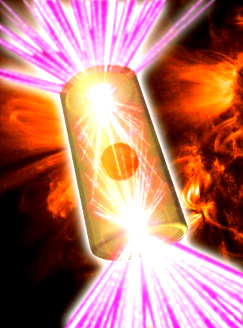Elements come together for fusion forward step
 Scientists are drawing closer to a goal they have sought for decades, which will provide the world with nearly limitless power supplies.
Scientists are drawing closer to a goal they have sought for decades, which will provide the world with nearly limitless power supplies.
More energy has been released by a fusion fuel cell than was put in.
A team in the US made the breakthrough in the development of nuclear fusion power, which promises great things if it ever reaches reality.
In experiments late last year scientists at the Lawrence Livermore National Laboratory in California produced more energy from a fusion reaction than the amount of energy put into the fusion fuel, the first time such a mark has been met.
Researchers are thrilled, but say the path that lies between now and a fusion-powered future is long and complicated.
“Really for the first time anywhere, we've gotten more energy out of this fuel than was put into the fuel. And that's quite unique. And that's kind of a major turning point, in a lot of our minds,” said physicist Dr Omar Hurricane.
“I think a lot of people are jazzed.”
Nuclear fusion is highly sought after because it carries almost none of the risk of its cousin; nuclear fission.
Fusion should be able to provide astounding amounts of power with zero pollution, radioactive waste or greenhouse gases.
As the names suggest – where fission requires ‘splitting’ an atom, fusion power comes from fusing them together.
The experiments that yielded the new record were undertaken late last year, and have now been published in the journal Nature.
The fusion fuel cell was made by coating the inside of a capsule less than 2 millimetres in diameter with a plasma of deuterium and tritium. The plasma fuel was sprayed as a coating inside the capsule just a few micrometres thick.
The cell was then zapped with an array of 192 lasers, causing the nuclei of the deuterium and the tritium to fuse. The fusion causes a neutron and an ‘alpha particle’ [http://en.wikipedia.org/wiki/Alpha_particle] to fling out and release their elemental energy.
In the experiments detailed in the latest report, more energy came from the fusion fuel than was fired into it, but the amount was still less than the total deposited into the target.
To illustrate how far the technology has come but still must go; the fusion energy yield from these experiments was ten-fold greater than when the project started, but is less than one-hundredth of the amount needed for full ignition.
The US has always invested heavily in opportunities to gain huge amounts of power, this advance bring the next level of the search even closer, after piles and time and money has been spent on the hunt.
“We have waited 60 years to get close to controlled fusion, and we are now close in both magnetic and inertial confinement research. We must keep at it,” says Steve Cowley, director of the Culham Centre for Fusion Energy.







 Print
Print